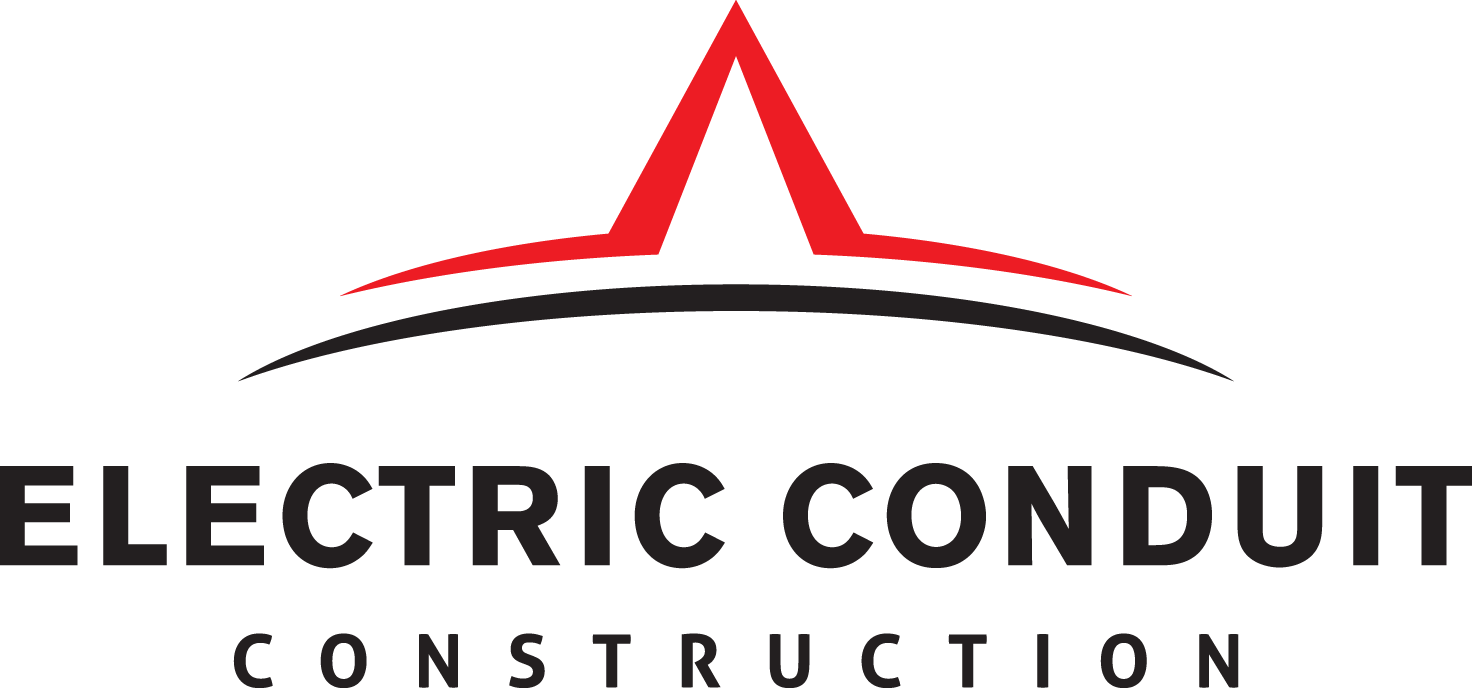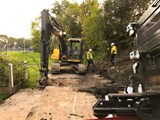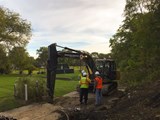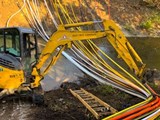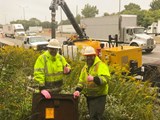HDD Pulls Back 26 Ducts
Construction projects require days, and sometimes weeks, of planning and preparation before the actual project can begin. This was the case when a major telecom company awarded Electric Conduit Construction the job of relocating 26 ducts that would ultimately carry fiber optic cable.
Directional drilling an 18” diameter hole, near other utilities and underneath rail road tracks is serious work. Engineered drawings were provided along with a scope of work. As a contractor our job is to make sure that we execute the plan, follow the permit limitations, and complete the project safely. This project required three separate drills, open cut work and termination of the duct package in manholes. Work areas close to moving traffic and moving rail cars required spotters and flaggers to maintain a safe work zone. Access through a park required building a mat road and restoration after the project was completed. Critical to the success of the project was the accurate location and identification of all utilities. This was accomplished with slot trenching and pot-holing utilizing a hydro-vac unit. The utilities were then marked with the depth noted.
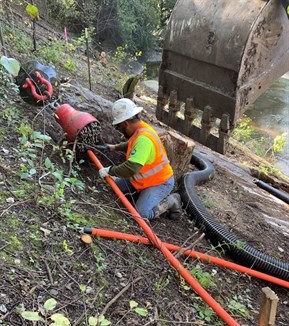
Attaching conduits to pullback head (1)
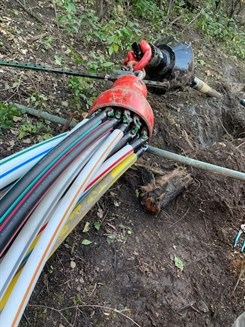
Attaching conduits to pullback head (2)
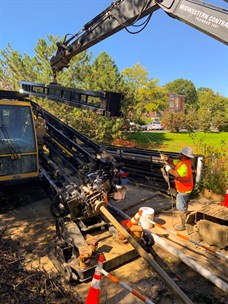
Site preparation and rig setup (1)
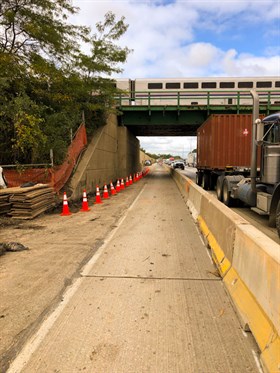
Site preparation and rig setup (2)
Pathways for the drill and track hoes were cleared and the surface was lined with mats. Silt fence and erosion controls were installed. The Vermeer 100 drill generates 100,000 lbs. of pullback force and 14,000 lbs. of rotational torque. This drill had plenty of power for the drilling, reaming and pullback operations.
Pulling back 26 1.5” ducts is risky. The alternative is multiple drills and fewer ducts on each drill. Our customer opted for a single drill and one pull. This minimized the chances for problems with the bore holes and any subsidence that might occur under the railroad tracks. We added three more ducts to make sure that if we did have a duct separation, we would still have 26 ducts to work with. Those bright colored HDPE pipes come to us from Blue Diamond Industries www.bdiky.com, they make great products and the colors certainly aid in duct identification. The project required two months for ROW clearing, road preparation, utility location, equipment and material move in and other site preparation.
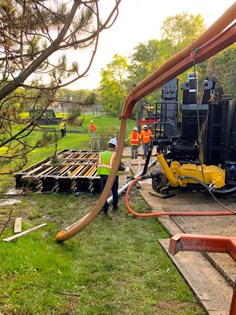
Drill entry point
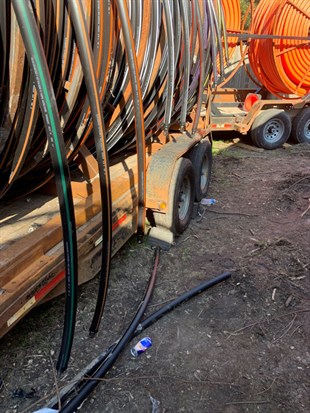
Conduit reels
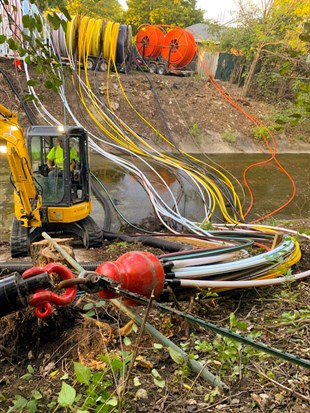
Conduit ready for pull back
The horizontal directional drill required 10 days to drill, ream and pull back 26 ducts along with the 3 spares for a total of 29 in all. No ducts separated from the reamer head, and the drills were completed successfully. Rail Road tracks were monitored with GPS enabled surveying equipment to detect the slightest amount of subsidence. None was recorded. The remaining open cut work and manhole work was carried on simultaneously, while the other drills were in progress. All ducts were spliced together. The project was completed by finish grading the disturbed areas and removing mats and work zone protection structures. Actual seeding was not required due to the future road work on the site.
With new ducts in place the way was cleared for toll road expansion to begin. Electric Conduit Construction crews carried out this work safely and on time for tollway expansion.
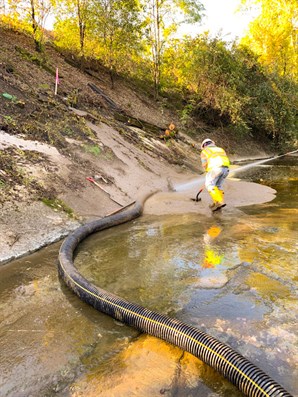
Managing drill mud with a hydro-vac unit
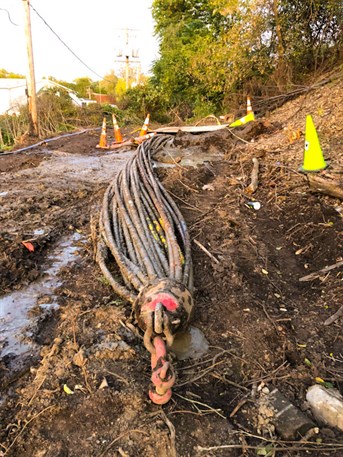
Successful pullback
PROJECT NOTES:
- Three drill shots - 1,300’, 860’ and 900’
- Drill and ream to an inside diameter of 18”
- Pull back of 26 1 ½” ducts + 3 spares - for fiber optic cable
- Drill equipment: Vermeer 100
- Pull Back force = 100,000 lbs.
- Rotational Torque = 14,000 lbs.
- Drill time = 10 days
Consider Electric Conduit Construction for your directional drilling and utility placement work. ECC offers a full range of construction services including HDD, fiber optic cable placement, testing, splicing and termination; Electrical work; Traffic control signal work; Civil work including grading, foundations, manholes and handholes.
Hats off to our great men and women who make this work possible. They do their work safely in all weather conditions, building the nation's broad band infrastructure.
